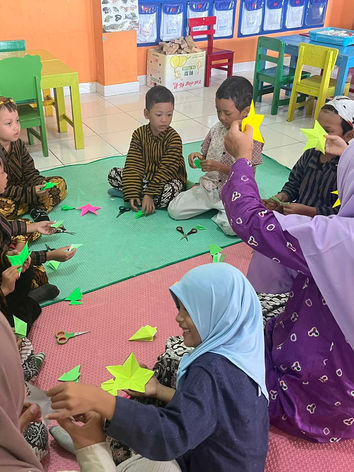
OBSERVATION ON TEACHER(s)
4.1 Planning for Teaching
The teaching process at TK ABA Nitikan follows a structured and student-centered approach, ensuring that lessons are engaging, relevant, and aligned with the Merdeka Curriculum and school goals. Teachers carefully plan their lessons to cater to different learning styles and incorporate multi-sensory learning strategies by using educational videos for lectures or concept mapping, songs, storytelling, and hands-on or project-based activities aligned with the weekly topic. These diverse teaching methods ensure that visual, auditory, and kinesthetic learners are actively engaged, making learning more effective and meaningful for all students. Additionally, teachers do not force children to learn but instead integrate lessons into play, allowing students to absorb concepts naturally while enjoying the learning process. This approach includes preparing a series of rotational activities throughout the week based on the topic and the children’s interests. For example, after introducing the topic on Monday, the activities from Tuesday to Friday are adjusted according to students’ preferences. If children show interest in drawing, the teacher provides drawing-related activities connected to the lesson. If they prefer sand play, the teacher incorporates the topic into sand-based activities, ensuring that learning remains child-centered, engaging, and enjoyable.
4.2. Preparing Lessons and Materials
Teachers carefully select and design lesson materials to enhance comprehension, engagement, and skill development among young learners. The materials and activities used in the classroom are tailored to different learning styles and developmental needs, ensuring that children actively participate and absorb concepts naturally.
Lessons and materials are prepared for the whole week. Teachers utilize videos to introduce topics in an engaging way. By using animated stories, real-life demonstrations, or concept mapping videos, teachers capture children’s attention and create a strong foundation for learning. I observed that teachers also integrate music and movement in the classroom. Music-based learning helps children retain information more effectively while making the classroom environment fun and dynamic. For example, when their weekly topic was rain, the teacher sang a song about rain, and the children connected the song to the concept of rain, reinforcing their understanding. Movement activities allow children to engage their bodies while learning, improving focus, coordination, and overall retention. After circle time, children engage in an icebreaker activity, where they either play games of their choice or follow the teacher’s lead. Additionally, project-based and hands-on activities are employed to promote experiential learning and deepen understanding of concepts. Activities such as painting, threading, and clay modeling help children explore concepts in a tangible and interactive way. By incorporating manipulative-based learning, teachers ensure that children learn through experience, making lessons more meaningful and effective.
4.3 Teaching in Class
Teachers at TK ABA Nitikan maintain a warm, nurturing, and structured learning environment where students feel secure and motivated to learn. Well-established classroom routines help students develop discipline and independence, allowing them to transition smoothly between activities while fostering responsibility. During classroom instruction, teachers implement positive reinforcement strategies to sustain student engagement and discipline. The star reward system is used to motivate students, encouraging them to complete tasks, assist peers, and demonstrate positive behavior.
Additionally, teachers at TK ABA Nitikan keep a positive and respectful approach to discipline. They do not shout or scold children but instead use gentle and effective strategies to address misbehavior. When needed, they get the student’s attention calmly, approach them directly, or involve them in discussions by offering advice and reminders.
4.4 Measurement and Evaluation
Assessment at TK ABA Nitikan is primarily formative and observational, focusing on student participation, engagement, and developmental progress rather than written tests. Since written work is not allowed in Kindergarten, teachers use various alternative assessment methods to evaluate learning outcomes and ensure that students receive the support they need.
Classroom participation and engagement serve as key indicators of student learning. Teachers observe how actively students contribute to discussions, respond to questions, and interact with peers during activities. These observations help assess children's understanding, communication skills, and level of involvement in the learning process.
Teachers maintain portfolio assessments, which include artworks, projects, and performance-based tasks as evidence of student learning and creativity. These portfolios help track individual progress over time, showcasing each child’s development in fine motor skills, cognitive growth, and creativity. Behavioral observations based on daily routines are another essential aspect of evaluation. Teachers monitor how children follow instructions, transition between activities, and interact with peers, identifying any challenges that may require additional support. Through continuous observation, teachers ensure that learning progress is effectively monitored, and each student receives personalized guidance tailored to their needs. Miss Fitroh keeps a detailed record of each child’s progress in her notebook, allowing her to track individual growth and provide targeted support when necessary.

















